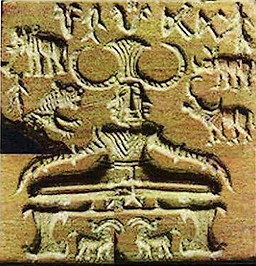

LOVE - SERVICE - DEVOTION - GRATITUDE - CONNECTION
About Yoga

Yoga is an ancient system and practice, specifically designed to alter the mind and reveal to us greater truths
about ourselves and our understanding of the natural world. Yoga is divine light and is both the practice and
the goal we seek through our practice. Yoga is paradoxically both dissolution and union. In more recent times,
yoga is often understood as a series of postures or stretches, however, it is through the physical that get a
chance to observe the more subtle aspects of being. This gives a chance to gain insight and greater control of
perceptive abilities. Said another way, yoga can be seen as spiritual journey through the tool of the physical
body.
One of the earliest potential evidences for yoga in India was found in the archeological site of the ancient
civilisation of the Indus Valley - the Paśupati seal (pictured left), thought to be a depiction of Śiva. There is still
debate around this but if true, would mean that the ancient practice of yoga has been with us at least since
2350-2000BCE.
It is around 500BCE with the emergence of the śramaṇa movement in India that we begin to see evidence of
the principles of yoga, as we understand it today, being developed. Different philosophical schools, including
Buddhism and Jainism, all essentially agreed on the foundational principle of saṃsāra, the concept of the cycle of birth and rebirth caused by karma. It is from this concept that the spiritual practice of yoga is founded, as the aim of the practice is to be liberated from this cycle. These different schools borrowed and disagreed with one another and all had philosophically refined ways of approaching liberation (mokṣa) and the details of saṃsāra and karma.
It is from this period that ascetic practices such as fasting, meditation, physical austerities and sexual abstinence are developed to counter karmic debts and to find freedom from the cycles of death and rebirth and also to influence ones incarnation for the next life.
It is from these ascetic practices, and other Tantric practices too, that Haṭha yoga is born from. Although Haṭha yoga and its practices, are mentioned in previous texts it is the Haṭha Yoga Pradīpikā, published in the 15th century, that has the biggest influence on asana based practices and our understanding of yoga as it is practiced today in modernity.
Yoga as it is practiced today is predominantly understood as Haṭha yoga, which is a physical practice that is adopted, alongside breathing (prāṇāyāma) and cleansing (kriyā and ṣaṭkarman) techniques for the purpose of purification, preparing the body and the mind for higher states of awareness. Although modern gurus such as Sri. K. Pattabhi Jois and B.K.S. Iyengar grounded their teaching in the philosophical framework of the Upaniṣad, the Yoga Sūtras of Patañjali and the Bhagavad Gītā, ultimately both of these teachers also paved the way for the physical based approach to yoga that is so popularised today. As yoga continues to evolve and grow in popularity, it is important to come back to these historical texts and the philosophy of yoga and find new ways to interpret their teachings. The path of yoga teaches us that the physical is important but it is a tool for gaining a greater understanding of the more subtle aspects of being and existence.
It is impossible to give a comprehensive insight into Indian religious and philosophical thought here, particularly as research continues, so this is written simply to provide some context of the history and to spark an interest that initiates your own further study.
Please find beneath a short list of books, some key primary texts in the yogic canon, and other secondary texts that provide context, chronology and a more detailed explanation of the philosophical concepts of yoga.
To read some of my work from my MA, please click here.
Recommended Reading (not an exhaustive list, but a good place to start):
Secondary texts:
De Michelis, E. (2004) - A History of Modern Yoga
Feurstein, G. (1998) - The Yoga Tradition
Iyengar, B.K.S. (1966) - Light on Yoga
Jois, Sri. K. P. (1999) - Yoga Mala
Mallinson, J. and Singleton, M. (2017) - Roots of Yoga
Singleton, M. (2010) - Yoga Body
Newcombe, S. (2019) - Yoga in Britain: Stretching Spirituality and Educating Yogis
Stern, E. (2019) - One Simple Thing
Subscriptions and additional resources:
Pushpam magazine
Namarupa magazine
Academia.edu
Oxford Centre for Hindu Studies (OCHS)
Archive.org
Wise Studies
Centre of Yoga Studies (SOAS)
Primary texts (various translations):
Upaniṣads
Yoga Sūtras of Patañjali
Bhagavad Gītā
Haṭha Yoga Pradīpikā

A statue of the great sage Patañjali, author of the Yoga Sūtras.